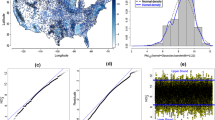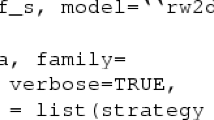Abstract
The spatially misaligned data problem occurs when data at different spatial scales need to be combined. Bayesian hierarchical models such as melding and downscaler approaches are suitable to solve this problem but their application is limited when MCMC is used for inference due to the high computational cost. The use of INLA and SPDE represents an alternative to MCMC for Bayesian inference that enables faster inference for latent Gaussian models. In this paper, we describe how INLA and SPDE can be adapted to fit Bayesian melding and downscaler models to combine spatially misaligned data. We assess the performance of the models using simulated and real data in a range of scenarios and sampling strategies and compare the suitability of the models in each situation. We also show how to obtain fine particulate matter (PM\(_{2.5}\)) predictions in the UK at a continuous surface and at policy-relevant spatial scales by combining spatially misaligned monitoring station data, satellite-derived indicators, road information, and environmental factors.











Similar content being viewed by others
References
Auchincloss AH, Gebreab SY, Mair C, Diez Roux AV (2012) A review of spatial methods in epidemiology, 2000–2010. Annu Rev Public Health 33:107–122
Baddeley A, Rubak E, Turner R (2015) Spatial point patterns: methodology and applications with R. CRC Press
Berrocal VJ, Gelfand AE, Holland DM (2010) A spatio-temporal downscaler for output from numerical models. J Agric Biol Environ Stat 15:176
Cameletti M, Lindgren F, Simpson D, Rue H (2013) Spatio-temporal modeling of particulate matter concentration through the spde approach. AStA Adv Stat Anal 97(2):109–131
Carslaw DC, Ropkins K (2012) Openair-an r package for air quality data analysis. Environ Model Softw 27:52–61
Center for International Earth Science Information Network, CIESIN CU (2021) Annual pm2.5 concentrations for countries and urban areas, 1998–2016
Chen W, Li Y, Reich BJ, Sun Y (2020) Deepkriging: spatially dependent deep neural networks for spatial prediction. arXiv:2007.11972
Costa AC, Soares A (2009) Homogenization of climate data: review and new perspectives using geostatistics. Math Geosci 41(3):291–305
Deng X, Zhang F, Rui W, Long W, Wang L, Feng Z, Chen D, Ding W (2013) Pm2.5-induced oxidative stress triggers autophagy in human lung epithelial a549 cells. Toxicol Vitro 27(6):1762–1770
Dicko A (2022) rgeoboundaries: a Client to geoBoundaries, A Political Administrative Boundaries Dataset. R package version 0.0.0.9000
Ding D, Xing J, Wang S, Liu K, Hao J (2019) Estimated contributions of emissions controls, meteorological factors, population growth, and changes in baseline mortality to reductions in ambient pm 2.5 and pm 2.5-related mortality in china, 2013–2017. Environ Health Pers 127(6):067009
Fenger J (1999) Urban air quality. Atmos Environ 33(29):4877–4900
Fuentes M, Raftery AE (2005) Model evaluation and spatial interpolation by bayesian combination of observations with outputs from numerical models. Biometrics 61:36–45
Gilks WR, Richardson S, Spiegelhalter D (1995) Markov chain Monte Carlo in practice. CRC Press
Green PJ, Łatuszyński K, Pereyra M, Robert CP (2015) Bayesian computation: a summary of the current state, and samples backwards and forwards. Stat Comput 25(4):835–862
Hastings WK (1970) Monte carlo sampling methods using markov chains and their applications
Heaton MJ, Datta A, Finley A, Furrer R, Guhaniyogi R, Gerber F, Gramacy RB, Hammerling D, Katzfuss M, Lindgren F, et al. (2017) Methods for analyzing large spatial data: A review and comparison. Preprint arXiv:1710.05013
Hersbach H, Bell B, Berrisford P, Biavati G, Horányi A, Muñoz Sabater J, Nicolas J, Peubey C, Radu R, Rozum I et al (2019) Era5 monthly averaged data on single levels from 1979 to present. Copernicus Clim Change Serv Clim Data Store 10:252–266
Lindgren, F, Bolin D, Rue H (2022) The spde approach for gaussian and non-gaussian fields: 10 years and still running. Spat Stat:100599
Lindgren F, Rue H (2015) Bayesian spatial modelling with r-inla. J Stat Softw 63:1–25
Lindgren F, Rue H, Lindström J (2011) An explicit link between gaussian fields and gaussian markov random fields: the stochastic partial differential equation approach. J R Stat Soc Ser B (Stat Methodol) 73(4):423–498
Lu M, Cavieres J, Moraga P (2023) A comparison of spatial and nonspatial methods in statistical modeling of no2: Prediction accuracy, uncertainty quantification, and model interpretation. Geogr Anal
Metropolis N, Rosenbluth AW, Rosenbluth MN, Teller AH, Teller E (1953) Equation of state calculations by fast computing machines. J Chem Phys 21(6):1087–1092
Moraga P (2019) Geospatial health data: modeling and visualization with R-INLA and shiny. CRC Press
Moraga P, Baker L (2022) rspatialdata: a collection of data sources and tutorials on downloading and visualising spatial data using r. F1000Research 11(770):770
Moraga P, Cramb SM, Mengersen KL, Pagano M (2017) A geostatistical model for combined analysis of point-level and area-level data using inla and spde. Spat Stat 21:27–41
OpenStreetMap contributors (2017) Planet dump retrieved from https://planet.osm.org . https://www.openstreetmap.org
Padgham M, Rudis B, Lovelace R, Salmon M (2017) osmdata. J Open Source Softw 2(14)
Rue H, Martino S, Chopin N (2009) Approximate bayesian inference for latent gaussian models by using integrated nested laplace approximations. J R Stat Soc Ser b (Stat Methodol) 71(2):319–392
Rue H, Riebler A, Sørbye SH, Illian JB, Simpson DP, Lindgren FK (2017) Bayesian computing with inla: a review. Annu Review Stat Appl 4:395–421
Saha A, Basu S, Datta A (2021) Random forests for spatially dependent data. J Am Stat Assoc:1–19
Schrödle B, Held L (2011) Spatio-temporal disease mapping using inla. Environmetrics 22(6):725–734
Vehtari A, Gelman A, Gabry J (2017) Practical bayesian model evaluation using leave-one-out cross-validation and waic. Stat Comput 27(5):1413–1432
Whittle P (1963) Stochastic-processes in several dimensions. Bull Int Stat Inst 40(2):974–994
Xing Y-F, Xu Y-H, Shi M-H, Lian Y-X (2016) The impact of pm2.5 on the human respiratory system. J Thoracic Dis 8(1):E69
Yang F, Tan J, Zhao Q, Du Z, He K, Ma Y, Duan F, Chen G (2011) Characteristics of pm 2.5 speciation in representative megacities and across china. Atmos Chem Phys 11(11):5207–5219
Author information
Authors and Affiliations
Corresponding author
Ethics declarations
Conflict of interest
The authors declare that there is no conflict of interest.
Additional information
Publisher's Note
Springer Nature remains neutral with regard to jurisdictional claims in published maps and institutional affiliations.
Rights and permissions
Springer Nature or its licensor (e.g. a society or other partner) holds exclusive rights to this article under a publishing agreement with the author(s) or other rightsholder(s); author self-archiving of the accepted manuscript version of this article is solely governed by the terms of such publishing agreement and applicable law.
About this article
Cite this article
Zhong, R., Moraga, P. Bayesian Hierarchical Models for the Combination of Spatially Misaligned Data: A Comparison of Melding and Downscaler Approaches Using INLA and SPDE. JABES 29, 110–129 (2024). https://doi.org/10.1007/s13253-023-00559-w
Received:
Revised:
Accepted:
Published:
Issue Date:
DOI: https://doi.org/10.1007/s13253-023-00559-w




